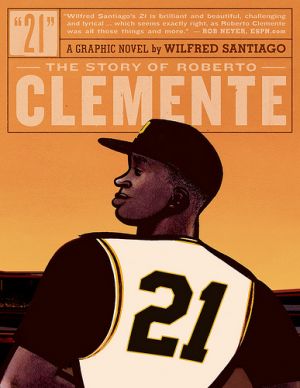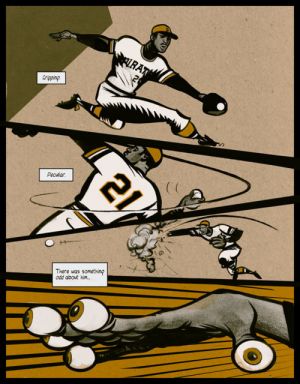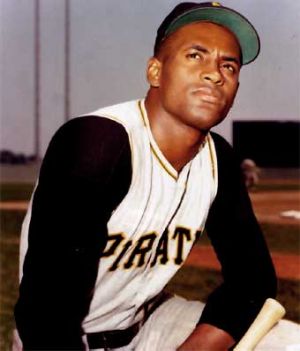Comics /
Spotlight /
Progressive Panels
21: The Story of Roberto Clemente
By Andy Frisk
April 10, 2011 - 18:20
It’s easy now to forget the barriers that the first African-American and Latino baseball players had to break down. Major League Baseball is now comprised of a multicultural as well as multinational mixture of talented athletes from all over the world, and this is the norm. It wasn’t always this way. Players like Roberto Clemente had to endure racial prejudice during his days as the right fielder for the Pittsburgh Pirates. Reaching his playing peak in the 1960s, Clemente helped The Pirates win two World Series, which included The Pirates stunning 1960 World Series victory over the heavily favored New York Yankees—The Yankees that boasted the likes of Mantle and Berra in their lineup and went by the moniker of “The Bronx Bombers.” Clemente would go on to win National League batting titles, collect 3,000 hits, and become a superstar both in Pittsburgh and in his native Puerto Rico. Perhaps most importantly though, Clemente would meet his end doing something that was as important to him as playing baseball and taking care of his family. He would die doing humanitarian work for the beleaguered and earthquake stricken Nicaragua.
 |
It might at first look like the life of Roberto Clemente Walker is one full of tragedy and hardship. While there definitely were some hardships, Clemente’s life was as unique and joyful as his persona and ball playing skills were, and Wilfred Santiago’s
21: The Story of Roberto Clemente reflects this uniqueness and joy through its own unique retelling of Clemente’s life. Like Clemente was while he was alive, graphic novels, sequential art, comic books, or whatever you want to call them, are often underrated, overlooked, and under appreciated. So what better medium is suited to bringing to life a larger than life character who was every bit as colorful and striking as Santiago’s art and storytelling is? Santiago touches on the racism of the era, the difficult political issues pertaining to Clemente’s native Puerto Rico, and the personal tragedies Clemente endured, such as the death of his sister at very young age, but the work overall seems to ooze joy and warmth not only though Santiago’s visual characterizations of Clemente, his family, and colleagues, but through his use of simple, warm colors that reflect the colors of Clemente’s major league team. This same color scheme also manages to create an aged feel and look that helps establish the 1950s and 60s setting. Santiago manages to blend realistic recreations of the baseball uniforms, baseball gear, common fashion, automobiles, and ballparks of the day with exaggerated features and body language that conveys much of the look and feel of Santiago’s goal. He's telling the overall joyful story of the life of a baseball great. He makes use of the unique power of sequential art to covey ideas with images that are not only striking, but sometimes quite odd. They are pictures that tell a thousand words and covey so much about the metaphoric realities that everyday game of baseball conveys. Many baseball analogies and metaphors permeate our collective unconscious, and are understood without even thinking about them. Images like Clemente’s fingertips sprouting eyeballs after making a throw from the outfield creates a visual metaphor that is just as striking as a written metaphor describing Clemente's accuracy of throwing, if not more so in this case. Some things are simply understood when seen or witnessed, and the images like the one mentioned above is one of them. Granted, Santiago does spell out the image for the sports uninitiated later on in the work, but it is one that for the most part doesn’t need explaining.
 |
Speaking of the uninitiated,
21: The Story of Roberto Clemente isn’t a work that solely appeals to, or is meant for, sports fans only. Anyone interested in the life of a barrier breaking, humanitarian, big hearted athlete who meets a tragic end while helping others, and leaves a legacy that is emulated by many contemporary ballplayers and athletes, will enjoy this work. This isn’t a work that is meant for sequential art fans only either. In fact, it serves as the perfect initiatory work for those new to the sequential art medium. Its themes of overcoming hardship, living up to your potential by facing down your challenges and challengers, and giving of oneself for the benefit of others are universal. The simple joy conveyed in this book is universally appealing as well. Baseball is a game that is full of life and story, and every year the game blooms in the spring with the trees and flowers of the season.
21: The Story of Roberto Clemente celebrates life, and new life, as much as it does baseball.
As a longtime (and long suffering) Pittsburgh Pirates fan, and larger fan of the game of baseball in general, who grew up not far from the crown city of Western Pennsylvania, and grew up on stories of Roberto Clemente,
21: The Story of Roberto Clemente was a personal treat. Santiago gets the details right, like the call letters of KDKA, the city’s long running and historic radio station, and the smoke and soot choked Pittsburgh skyline. The city’s steel mills are no more though, and the current Pirates are no where near the caliber of the teams of the 1960s and 1970s. There is always hope though. There’s some new and exciting talent on the field this year. Who knows? Perhaps the talented young players Jose Tabata, Andrew McCutcheon, and Pedro Alvarez will end up leading the team back to greatness. These players though, like many players in professional sports, will learn that greatness is comprised of more than on the field prowess. They need look no further than the great Roberto Clemente as an example, and to Wilfred Santiago’s great biography of him for a unique re-imagining of this greatness.
Rating: 10 /10
Last Updated: January 17, 2025 - 08:20


